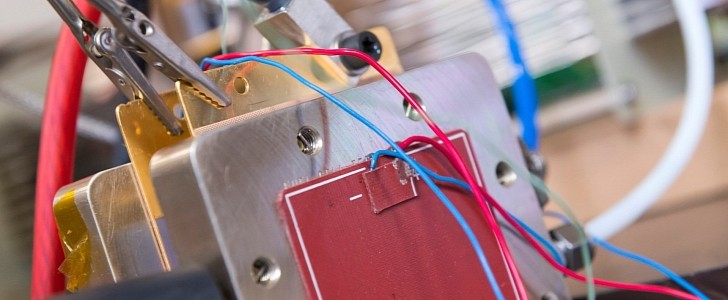Hydrogen fuel cells are used to convert hydrogen into electricity. To facilitate the reaction that produces the electricity, they use an expensive platinum catalyst. Scientists at Imperial College London have created a catalyst using only iron, carbon, and nitrogen, which are cheap and readily available materials.
Hydrogen is the most abundant element on Earth and yet its use is hampered by the high costs of sourcing it, storing it, and using it. Despite being everywhere, it’s almost nowhere in pure form. As such, expensive (and energy-hungry) methods need to be devised to extract it from various other products like water or natural gases. These are mostly polluting processes, which negate hydrogen’s role as a green fuel.
Storing hydrogen is also complicated, requiring high-pressure tanks usually made out of carbon-fiber materials. Burning hydrogen directly in a combustion engine is pretty straightforward, but a more efficient (and cleaner) way is to transform it into electricity using a fuel cell. Unfortunately, fuel cells are also very expensive to make because they use scarce materials like platinum to facilitate the reaction that leads to electricity production.
The situation is about to change drastically though, as a team of researchers at Imperial College London created a catalyst made out of iron, carbon, and nitrogen to replace the expensive platinum components. When used wisely, these are just as efficient as the precious metal in operating the fuel cell at high power.
“Currently, around 60% of the cost of a single fuel cell is the platinum for the catalyst,” says Lead researcher Professor Anthony Kucernak, from the Department of Chemistry at Imperial. “To make fuel cells a real viable alternative to fossil-fuel-powered vehicles, for example, we need to bring that cost down.”
To make it work, the team produced a catalyst where all the iron was dispersed as single atoms within an electrically conducting carbon matrix. Using a process called transmetallation resulted in radically different properties as opposed to bulk iron, acting as a good substitute for platinum. In lab tests, the researchers showed that a single atom iron catalyst has a similar performance to platinum-based catalysts in a real fuel cell system.
The iron catalyst allows for building cheaper fuel cells that will significantly lower the cost of fuel-cell applications. For now, the iron-based catalyst isn’t quite as durable as the one made with platinum, but the team is working on improving the system. Fuel cells have great potential for electricity generation not only for transportation but also for buildings and communities. Hopefully, clean hydrogen generation will also catch up, helping with our environmental goals.
Storing hydrogen is also complicated, requiring high-pressure tanks usually made out of carbon-fiber materials. Burning hydrogen directly in a combustion engine is pretty straightforward, but a more efficient (and cleaner) way is to transform it into electricity using a fuel cell. Unfortunately, fuel cells are also very expensive to make because they use scarce materials like platinum to facilitate the reaction that leads to electricity production.
The situation is about to change drastically though, as a team of researchers at Imperial College London created a catalyst made out of iron, carbon, and nitrogen to replace the expensive platinum components. When used wisely, these are just as efficient as the precious metal in operating the fuel cell at high power.
“Currently, around 60% of the cost of a single fuel cell is the platinum for the catalyst,” says Lead researcher Professor Anthony Kucernak, from the Department of Chemistry at Imperial. “To make fuel cells a real viable alternative to fossil-fuel-powered vehicles, for example, we need to bring that cost down.”
To make it work, the team produced a catalyst where all the iron was dispersed as single atoms within an electrically conducting carbon matrix. Using a process called transmetallation resulted in radically different properties as opposed to bulk iron, acting as a good substitute for platinum. In lab tests, the researchers showed that a single atom iron catalyst has a similar performance to platinum-based catalysts in a real fuel cell system.
The iron catalyst allows for building cheaper fuel cells that will significantly lower the cost of fuel-cell applications. For now, the iron-based catalyst isn’t quite as durable as the one made with platinum, but the team is working on improving the system. Fuel cells have great potential for electricity generation not only for transportation but also for buildings and communities. Hopefully, clean hydrogen generation will also catch up, helping with our environmental goals.






